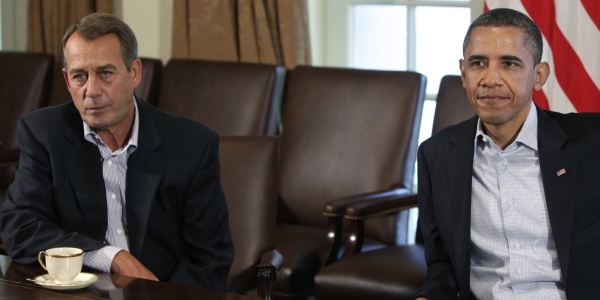Op-Ed: How to Pay for the Payroll Tax Cut
The Atlantic | December 12, 2011
A solution to pay for $300 billion of stimulus that doesn't include the words "tax hike" or "spending cut"

(Reuters)
It's become a Christmas tradition for Congress to end the year by extending all the policies which expire at year's end. There is the Alternative Minimum Tax, which has to be "patched" every year so that it reaches only four million taxpayers instead of thirty million. There is the looming 27% cut in Medicare payments to doctors which policymakers will need to protect with a "Doc Fix." And on top of that, this year, we're dealing with the expiration of a payroll tax holiday and extended unemployment benefits meant to help boost a weak economy.
Extending these provisions every year is really expensive. It comes out to about $275 billion for a single year. That's more than a quarter-trillion dollars added to nation's credit card.
But here's the good news. For the first time in a long time, our politicians are actually talking about finding spending cuts and tax increases to finance the costs of these extensions. Democrats are focusing on a new tax for millionaires. Republicans are focusing on cuts that will impact the size and cost of the federal workforce. With our debt already on a dangerous path, anything worth having is also worth paying for. But Democrats will balk at an all-cuts solution, and Republicans have made it clear they don't want to raise taxes.
I have a different solution. It's a single, simple change. It wouldn't drastically cut domestic spending. It wouldn't change tax rates. Instead, it would pay for a payroll tax cut, AMT patch, and unemployment extension with a slow, phased-in policy called "chained CPI." Don't know what that is? Let me explain.
WHAT'S CHAINED CPI?
Every year, wages and prices go up. The government wants to measure this inflation to index everything from Social Security checks to tax brackets. The government makes these measurements by focusing on a "basket of goods" to compile its so-called consumer price index, or CPI.
The weakness of regular CPI is that we don't account for when consumers start changing their relative buying habits. If the prices of apples skyrocket, the regular CPI assumes cost-of-living will go way up. But in the real world, most people just buy fewer apples and more oranges.
Moving to the "chained CPI" corrects for this technical flaw by trying to provide an honest assessment of each month's basket and creating a "chain" between them. Moving to a more realistic measure of inflation would save well over $200 billion over the next decade, including from Social Security, other inflation-index programs, and from the tax code.
5 REASONS IT'S A GREAT IDEA
1) Social Security Savings Pay for Social Security Losses: Since the payroll tax is used to finance Social Security benefits, a payroll tax holiday necessarily takes revenue out of the system -- about $120 billion worth. Last year, we made up that money through a transfer from general revenue; but those types of transfers -- necessary as they might be -- threaten the contributory nature of the program. The chained CPI, though, would lead to savings within the Social Security program from lower COLAs. This would allow the Social Security trust funds to make up the lost revenue in ten years; and after that the chained CPI would help to close over a fifth of the long-term funding cap.
2) Income Tax Revenue for an Income Tax Cut: Patching the AMT will cost us $90 billion worth of income tax revenue over the next year or so. But because the income tax has so many parameters indexed to inflation, switching to the chained CPI can help us make that money back. The main reason chained CPI raises revenue is because of something called "bracket creep," where growing incomes push people into higher income tax brackets over time. Because we over-measure inflation, though, income is not being pushed as fast as they should in an inflation-indexed tax code. Using the chained CPI to index the tax code would reduce the deficit by about $60 billion through 2021, and make future AMT patches roughly $40 to $50 billion cheaper.
3) Other Spending Cuts for Other Spending: In addition to the Social Security and revenue savings, switching to the chained CPI would save over $50 billion over a decade by slowing the growth of various government benefits and eligibility thresholds. This mandatory savings should be enough to pay for an extension of unemployment benefits.
4) A Pro-Growth Phase-In: Sharp immediate deficit reduction could prove economically dangerous in a time of weak growth, but the markets also need to see a credible plan to reduce the deficit over the medium and long-term. The chained CPI saves money because it grows a tiny 0.25% slower than the current CPI measure. Because of this, savings are very small up front but compound and grow over time in a way that provides substantial deficit reduction over the long-term.
5) It's a No Brainer: The chained CPI is the right measure of inflation -- economists and experts from the left and right agree on that. Ideally, it shouldn't even be an offset for new deficit spending -- we should just do it. Of all the hard and painful choices we need to make to right out fiscal situation, measuring inflation right is not one of them. We should get it done now, and move on to the serious choices.
What's Next
-
Image

-
Image

-
